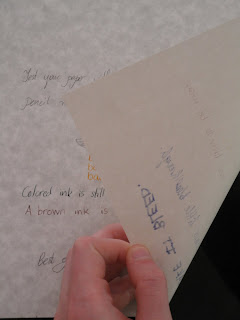A quick update on the tome: I'm planning a trip to Ann Arbor for leather, but that has to wait until next Saturday. I'll be working on cover designs until then and hopefully will have a post going up in the next few days.
In the meantime, here's something completely unrelated.
I'm really not happy unless I have about six different projects going on, enabling me to flit between them at will. For example, in addition to bookbinding, I'm learning to paint war-gaming miniatures. Most people get into this by way of playing the actual games, but I do it just because I think it's fun and a good exercise.
To be clear, here's what this involves: You start with a tiny, grey plastic or metal figurine from a place like Games Workshop or Reaper Miniatures. You apply paint. Lots of it. Many times. Sometimes, you curse. Eventually you end up with a full-color statuette in some degree of artistry. Typically, you then send the model off to war, using dice and codices to rain destruction upon other models like it.
Brian, of course, was the one who introduced me; he's an avid player of Warhammer in both its 40k and Fantasy incarnations. He probably owns models from nearly every civilization in the 40k range and, for several of them, has armies in varying degrees of completeness, all of which he paints himself (have a look: Allerka on DeviantART).
I do believe he saw in me a potential gaming disciple or reliable opponent, possibly both, but I never showed much interest in the games. He, being a cunning man, therefore tempted me, a crafty girl, by offering me models to paint. I suppose he hoped I'd paint so many models they'd just end up as an army, and then, well! I'd surely want to use that army. Unfortunately, I'm both stubborn and interested in diversifying, so I still have nothing resembling even a ragged army, just a lot of totally unrelated, meticulously painted models.
Here, for example, is an Elven sorceress, both buxom and scantily clad, not to mention clearly unable to move her legs:
I've been working on her for probably a couple months, on and off, and as you can see the paint job is very nearly complete. Really all that's wanting is to clean up a few blotchy spots and then perhaps add some embroidery to her cape.
I'm very proud of her sword, so let me show you a closeup:
There are two ways to paint a metal surface such as a sword: (1) using metallic paints, which contain tiny metal flakes to give the paint a natural shimmer, or (2) using regular nonmetallic paints, which are less flashy and require more finesse to actually look like metal. In the past I've had mixed results with metallic paints -- they tend to get out of hand and just look gaudy. I was quite sure this model didn't need any gaudy, cheap metallic tricks, so I took a stab (hurr hurr) at nonmetallics and here's the result. Easier than I expected, as it turns out.
As I was looking for advice on painting the look of steel, I stumbled across a technique for painting a chrome look. Now, the soul of artistry is getting distracted by sorta cool things you're not sure you could ever use but they're cool, dammit. So, naturally, I grabbed the first suitable model I could find to practice on and achieved... well, kind of a chrome look on the leg and back plates of this Tyrannid bug.
So, that still needs some work before it's as convincing as, I don't know, this pantswetting chrome warrior. But it'd be a boring world if everything we tried went just right the first time.
Hm... I had more to share, but it's rather late, so that'll have to do for now. Perhaps I'll post again tomorrow. Until then, be crafty!























